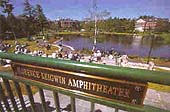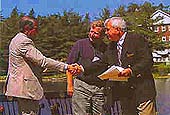Gratitude for a Life's Journey

As each speaker described the work and philanthropy involved in the restoration of Lake Andrews, an expression of this Bates story unfolded just beyond the lectern.
There, along the winding path of the new Burgoyne Walk, a father followed his daughter, both drawn from the walkway, along the grass, to the water’s edge.
As President Harward described Lake Andrews’ “appeal to the natural and spiritual instincts in all of us,” the child and father gazed out onto the pond.
As Jack Keigwin ’59 talked about his difficult childhood and his arrival at Bates, where he was “protected, encouraged, and challenged,” the child and father took in the sweep of the shoreline, the river rock along the water’s edge, and the drifts of ornamental grasses and wildflowers.
 Reunion 1999 in June marked the dedication of the restored Lake Andrews and the new Keigwin Amphitheater and Burgoyne Lakeside Walk, made possible by a $1.1-million Reunion gift from Jack ’59 and Beverly Keigwin of Warwick, R.I.
Reunion 1999 in June marked the dedication of the restored Lake Andrews and the new Keigwin Amphitheater and Burgoyne Lakeside Walk, made possible by a $1.1-million Reunion gift from Jack ’59 and Beverly Keigwin of Warwick, R.I.
The dedication ceremonies also celebrated the historical ties between Bates and the Andrews family. Bert Andrews ’74, celebrating his 25th Reunion, is the third generation of Andrews to attend Bates. His great-uncle, Delbert Andrews ’10, namesake of Lake Andrews and Andrews Road, served as assistant treasurer and superintendent of grounds and buildings at Bates from 1914 to 1920.
“I’m here at Reunion with my children – the fourth generation of my family getting to know the Bates campus,” said Bert Andrews, who offered the crowd of some 500 a brief history of Lake Andrews.
Created during President Phillips’ tenure at Bates, Lake Andrews was carved from a low, scrubby spot on campus. Almost immediately, students snickered at “Prexy’s Puddle.” Water quality was always an issue. In 1958, shortly after construction of the pond, a Bates Student reporter predicted that between the green grass on the banks and the green algae in the pond, “no one will notice the difference between the grass and the hole in the ground.”
The Keigwins stepped forward in the mid-1990s to encourage and offer help with the restoration. “Not only did they offer financial support, but they worked with the College to make the College better,” said Jack’s classmate, Burton Harris ’59, a member of the Bates Board of Fellows.
 The recent restoration removed silt, put a layer of sand on the pond bottom, created a filtration system for runoff, rebuilt the shoreline, and restored the walkway around the pond. Environmental consultant Scott Williams ’71 worked on the project, which was designed by the Halvorson Company of Boston, Mass. President Harward praised the “mix of people and ideas” involved in the restoration.
The recent restoration removed silt, put a layer of sand on the pond bottom, created a filtration system for runoff, rebuilt the shoreline, and restored the walkway around the pond. Environmental consultant Scott Williams ’71 worked on the project, which was designed by the Halvorson Company of Boston, Mass. President Harward praised the “mix of people and ideas” involved in the restoration.
The Keigwins’ philanthropy, Harward added, shows how “fond Bates memories can combine with aspirations for our College to create a gem for the campus.”
The amphitheater, created with 500 tons of granite from a quarry in Lincolnville, is named for Jack’s aunt, Florence, who helped raise Jack after his father died just weeks before he arrived at Bates. “She worked in a shoe factory until she was 70. She instilled in me a work ethic and a love of the environment.” The walkway is named for Beverly’s mother, Marjorie Burgoyne, “the woman next door, a businesswoman ahead of her time, who enriched my entrepreneurial bent.” The Keigwins, who are the parents of Scott ’86, together own F.H. French Co., designer and builder of office complexes in Lincoln, R.I.
Jack Keigwin also offered gratitude to Milt Lindholm ’35, dean emeritus of admissions, who was at the event with his wife, Jane ’37. Keigwin remembers hitching a ride to Bates, meeting with Lindholm, and coming away with a scholarship that made Bates possible for him. “Milt gave a confused young man a chance, and that was the turning point for me, and it defined my life’s journey,” he said.
“Bates made a tremendous investment in me,” Keigwin concluded. “And I vowed that Bates would someday get a return on that investment.”